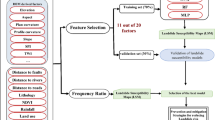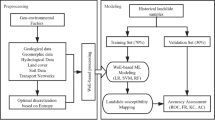Abstract
An earthquake with Ms 7.0 (33.2° N, 103.8° E) occurred in Jiuzhaigou County of Sichuan Province in China on 8 August 2017. This earthquake triggered a large number of landslides in the study area. Although the susceptibility quality level index has improved, the high-quality assessments still have remained rare. We adopted three models, including the logistic regression (LR), support vector machine (SVM), and random forest (RF) to study the quality performance of the susceptibility distribution rule of earthquakes induced landslides. We used satellite images of before and after earthquakes and landslides as well. We used the area under receiver operating characteristic (ROC) curve (AUC) and ratio to evaluate the model’s accuracy and quality performance, including the mapping availability susceptibility assessment. This study reveals that RF has the highest ratio (2.07) as compared to the LR (1.78) and SVM (1.90). The result shows that RF has more potential to implement future experiments in Sichuan Province because of a better performance quality in the susceptibility assessment of landslides induced by earthquakes.














Similar content being viewed by others
Change history
24 February 2021
A Correction to this paper has been published: https://doi.org/10.1007/s12517-021-06755-7
References
Ahmed B (2015) Landslide susceptibility modelling applying user-defined weighting and data-driven statistical techniques in Cox’s Bazar Municipality, Bangladesh. Nat Hazards 79(3):1707–1737
Ali SA, Pirasteh S (2004) Geological applications of Landsat Enhanced Thematic Mapper (ETM) data and Geographic Information System (GIS): mapping and structural interpretation in south-west Iran, Zagros Structural Belt. Int J Remote Sens 25(21):4715–4727
Ayalew L, Yamagishi H (2005) The application of GIS-based logistic regression for landslide susceptibility mapping in the Kakuda-Yahiko Mountains. Central Japan Geomorphol 65(1–2):15–31
Bourenane H, Bouhadad Y, Guettouche MS (2014) GIS-based landslide susceptibility zonation using bivariate statistical and expert approaches in the city of Constantine (Northeast Algeria). B Eng Geol Environ 74(2):337–355
Brabb EE, Pampeyan EH, Bonilla MG (1972) Landslide susceptibility in San Mateo County, California. Miscellaneous Field Studies Map.
Can T, Nefeslioglu HA, Gokceoglu C (2005) Susceptibility assessments of shallow earthflows triggered by heavy rainfall at three catchments by logistic regression analyses. Geomorphology. 72(1–4):250–271
Cao J, Zhang Z, Wang C, Liu J, Zhang L (2019) Susceptibility assessment of landslides triggered by earthquakes in the Western Sichuan Plateau[J]. Catena 175(175):63–76
Carrara A (1983) Multivariate models for landslide hazard evaluation. Math Geol 15(15):403–426
Chen W, Shahabi H, Shirzadi A, Hong H, Akgun A, Tian Y, Liu J, Zhu AX, Li S (2018) Novel hybrid artificial intelligence approach of bivariate statistical-methods-based kernel logistic regression classifier for landslide susceptibility modeling. BullInt Assoc Eng Geol 78:4397–4419. https://doi.org/10.1007/s10064-018-1401-8
Chen W, Zhao X, Shahabi H, Shirzadi A, Khosravi K, Chai H, Zhang S, Zhang L, Ma J, Chen Y, Wang X, Bin Ahmad B, Li R (2019) Spatial prediction of landslide susceptibility by combining evidential belief function, logistic regression and logistic model tree. Geocarto Int 34:11–1201. https://doi.org/10.1080/10106049.2019.1588393
Dai FC, Lee CF, Ngai YY (2002) Landslide risk assessment and management: an overview. Eng Geol 64(1):65–87
Dou J, Yamagishi H, Pourghasemi HR (2015) An integrated artificial neural network model for the landslide susceptibility assessment of Osado Island, Japan. Nat Hazards 78(3):1–28
Elayaraja S, Ganapathy GP (2015) Evaluation of seismic hazard and potential of earthquake-induced landslides of the Nilgiris, India. Nat Hazards 78(3):1997–2005. https://doi.org/10.1007/s11069-015-1816-5
Erener A, Düzgün HSB (2012) Landslide susceptibility assessment: what are the effects of mapping unit and mapping method? Environ Earth Sci 66:859–877
Faris F, Wang F (2014) Investigation of the initiation mechanism of an earthquake- induced landslide during rainfall: a case study of the Tandikat landslide, West Sumatra, Indonesia. Geoenviron Disast 1(1):1–18
Farrokhnia A, Pirasteh S, Pradhan B, Pourkermani M, Arian M (2011) A recent scenario of mass wasting and its impact on the transportation in Alborz Mountains, Iran: contribution from Geo information technology. Arab J Geosci 4:1337–1349
Feng Z, Tang Y, Yang Y, Zhang D (2008) Relief degree of land surface and its influence on population distribution in China. J Geogr Sci 18(2):237–246
Hong H, Pourghasemi HR, Pourtaghi ZS (2016) Landslide susceptibility assessment in Lianhua County (China): a comparison between a random forest data mining technique and bivariate and multivariate statistical models. Geomorphology. 259:105–118
Hosseinalizadeh M, Karaminejad N, Rahmati O, Keesstra S, Alinejad M, Behbahani AM (2019) How can statistical and artificial intelligence approaches predict piping erosion susceptibility? Sci Total Environ 646:1554–1566
Jaafari A, Najafi A, Pourghasemi HR et al (2014) GIS-based frequency ratio and index of entropy models for landslide susceptibility assessment in the Caspian forest, northern Iran. Int J Environ Sci Technol I 11(4):909–926
Juliev M, Mergili M, Mondal I, Nurtaev B, Pulatov A, Hübl J (2019) Comparative analysis of statistical methods for landslide susceptibility mapping in the Bostanlik District, Uzbekistan. Sci Total Environ 653:801–814
Kaya A, Alemdağ S, Dağ S (2015) Stability assessment of high-steep cut slope debris on a landslide (Gumushane, NE Turkey). Bull Eng Geol Environ 75(1):89–99
Lai J-S, Tsai F (2019) Improving GIS-based landslide susceptibility assessments with multi-temporal remote sensing and machine learning. Sensors 19(17):3717. https://doi.org/10.3390/s19173717
Lee S, Talib JA (2005) Probabilistic landslide susceptibility and factor effect analysis. Eng Geol 47(7):982–990
Lee S, Ryu JH, Min K, Won JS (2003) Landslide susceptibility analysis using GIS and artificial neural network. Earth Surf Process Landf 28(12):1361–1376
Lee CT, Huang CC, Lee JF (2008) Statistical approach to earthquake-induced landslide susceptibility. Eng Geol 100(1–2):43–58
Li YS, Huang C, Yi SJ et al (2017a) Study on seismic fault and source rupture tectonic dynamic mechanism of Jiuzhaigou Ms7.0 earthquake. J Eng Geol 25(4):1141–1150 (In Chinese)
Li L, Liu R, Pirasteh S, Chen X, He L, Li J (2017b) A novel genetic algorithm for optimization of conditioning factors in shallow translational landslides and susceptibility mapping. Arab J Geosci 10(9). https://doi.org/10.1007/s12517-017-3002-4
Li X, Ling S, Sun C et al (2019) Integrated rockfall hazard and risk assessment along highways: an example for Jiuzhaigou area after the 2017 Ms 7.0 Jiuzhaigou earthquake, China. J Mt Sci 16(6):1318–1335
Liu HL, Ma YB, Zhang WG et al (2020) Summary of the application of big data technology in geological disaster prevention. J Disast Prevent Mitigat Eng:1–13
Meten M, Bhandary NP, Yatabe R (2015) GIS-based frequency ratio and logistic regression modelling for landslide susceptibility mapping of Debre Sina area in Central Ethiopia. J Mt Sci 12(6):1355–1372
Pandit SN, Maitland BM, Pandit LK, Poesch MS, Enders EC (2017) Climate change risks, extinction debt, and conservation implications for a threatened freshwater fish: carmine shiner (Notropis percobromus). Sci Total Environ 598:1–11
Pawluszek K, Borkowski A, Tarolli P (2018) Sensitivity analysis of automatic landslide mapping: numerical experiments towards the best solution. Landslides 15:1851–1865
Pham BT, Tien Bui D, Prakash I, Dholakia MB (2017) Hybrid integration of multilayer perceptron neural networks and machine learning ensembles for landslide susceptibility assessment at Himalayan area (India) using GIS. CATENA 149:52–63
Pirasteh S, Shamsipur G, Liu G, Zhu Q, Ye C (2020) Developing landslide deformation geometric algorithm for modelling and simulation incorporating LiDAR-derived DEMs and UAV. Earth Science Informatics. pp: 1-15, https://doi.org/10.1007/s12145-019-00437-5.
Pourghasemi HR, Kerle N (2016) Random forests and evidential belief function-based landslide susceptibility assessment in Western Mazandaran Province, Iran. Environ Earth Sci 75:1–17
Reichenbach P, Rossi M, Bruce DM, Mihir M, Guzzettia F (2018) A review of statistically-based landslide susceptibility models. Earth-Sci Rev 180:60–91. https://doi.org/10.1016/j.earscirev.2018.03.001
Shirani K, Pasandi M, Arabameri A (2018) Landslide susceptibility assessment by Dempster–Shafer and Index of Entropy models, Sarkhoun basin, Southwestern Iran. Nat Hazards 6:1–40
Torgoev A, Havenith HB (2013) Parametric numerical study of seismic slope stability and verification of the Newmark method. In: Earthquake-Induced Landslides. Springer, Berlin Heidelberg. https://doi.org/10.1007/978-3-642-32238-9_68
Trigila A, Iadanza C, Esposito C, Scarascia-Mugnozza G (2015) Comparison of logistic regression and random forests techniques for shallow landslide susceptibility assessment in Giampilieri (NE Sicily, Italy). Geomorphology 249:119–136
Vapnik V, Cortes C (1995) Support-vector networks. Mach Learn 20(3):273–297
Wan S (2009) A spatial decision support system for extracting the core factors and thresholds for landslide susceptibility map. Eng Geol 108(3-4):237–251
Wang KL, Lin ML (2010) Development of shallow seismic landslide potential map based on Newmark’s displacement: the case study of Chi-Chi earthquake. Taiwan Environ Earth Sci 60(4):775–785
Wang J, Jin W, Cui YF, Zhang WF, Wu CH, Alessandro P (2018) Earthquake-triggered affecting a UNESCO Natural Site: the 2017 Jiuzhaigou Earthquake in the World National Park, China. J Mt Sci 15(7):1412–1428
Wang Y, Wu X, Chen Z, Ren F, Feng L, Du Q (2019) Optimizing the predictive ability of machine learning methods for landslide susceptibility mapping using SMOTE for Lishui City in Zhejiang Province, China. Int J Environ Res Public Health 2019(16):368. https://doi.org/10.3390/ijerph16030368
Wei-Le L, Huang RQ, Qiang X (2013) Rapid prediction of co-seismic landslides triggered by Lushan earthquake, Sichuan, China. J Chengdu Univ Technol 40(3):264–274. https://doi.org/10.3969/j.issn.1671-9727.2013.03.06
Wu S, Jin Y, Zhang Y (2004) Investigations and assessment of the landslide hazards of Fengdu county in the reservoir region of the Three Gorges project on the Yangtze River. Environ Geol 45(4):560–566
Xu C, Xu X, Yu G (2013) Landslides triggered by slipping-fault-generated earthquake on a plateau: an example of the 14 april 2010, ms 7.1, yushu, china earthquake. Landslides 10(4):421–431
Yan F, Zhang Q, Ye S, Ren B (2019) A novel hybrid approach for landslide susceptibility mapping integrating analytical hierarchy process and normalized frequency ratio methods with the cloud model. Geomorphology. 327:170–187
Yang L, Nollen N, Ahluwahlia JS (2015) An application in identifying high-risk populations in alternative tobacco product use utilizing logistic regression and CART: a heuristic comparison. BMC Public Health 15(1):1–9
Ye C, Li Y, Liang L, Pirasteh S, Cui P, Li J (2019) Landslide detection of hyperspectral remote sensing data based on deep learning with constrains. IEEE J Select Topic Appl Earth Observ Remote Sens 12:5047–5060. https://doi.org/10.1109/JSTARS.2019.2951725
Zhang Y, Zhang G, Hetland EA et al (2018) Source fault and slip distribution of the 2017 Mw 6.5 Jiuzhaigou, China, earthquake and its tectonic implications. Seismol Res Lett 89(4):1345–1353
Zhou S, Fang L (2015) Support vector machine modeling of earthquake-induced landslides susceptibility in central part of Sichuan province, China. Geoenviron Disast 2(1):1–12
Zhu Q, Chen L, Hu H, Pirasteh S, Li H, Xie X (2020) Unsupervised feature learning to improve transferability of landslide susceptibility representations. IEEE J Sel Top Appl Earth Obs Remote Sens 13:2917–3930. https://doi.org/10.1109/JSTARS.2020.3006192
Acknowledgements
The authors like to express appreciation to the lab’s staff for their valuable comments and contributions. We also appreciate Professor Jonathan Li, from the University of Waterloo, Canada, for his support during the research.
Funding
The funding of this study is from the Foundation of Sichuan Educational Committee (No.14ZB0071). We also received funds from the Science and Technology Department of the Sichuan Province Technology Support Program (No.2012FZ0018).
Author information
Authors and Affiliations
Corresponding author
Ethics declarations
Conflict of interest
The authors declare that they have no conflict of interest.
Additional information
Responsible Editor: Biswajeet Pradhan
The original online version of this article was revised: The corresponding author missed the affiliation of the sixth co-author, Himan Shahabi, and was incorrectly presented as “Southwest Jiaotong University”. The correct sixth co-author affiliation is “Department of Geomorphology, Faculty of Natural Resources, University of Kurdistan, Sanandaj, Iran and Department of Zrebar Lake Environmental Research, Kurdistan Studies Institute, University of Kurdistan, Sanandaj, Iran. Given in this article is the corrected affiliation of sixth co-author.
Rights and permissions
About this article
Cite this article
Liu, R., Li, L., Pirasteh, S. et al. The performance quality of LR, SVM, and RF for earthquake-induced landslides susceptibility mapping incorporating remote sensing imagery. Arab J Geosci 14, 259 (2021). https://doi.org/10.1007/s12517-021-06573-x
Received:
Accepted:
Published:
DOI: https://doi.org/10.1007/s12517-021-06573-x




